Vancouver's Chinatown National Historic Site
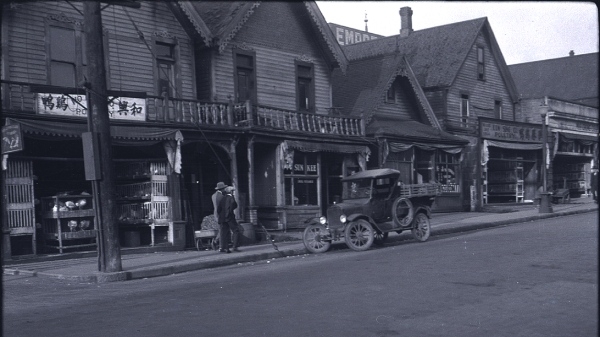
© M.O. Hammond fonds / Archives of Ontario / Wikimedia Commons / Public domain
Vancouver Chinatown was designated as a national historic site in 2011.
Commemorative plaque: Pender Street, Vancouver, British ColumbiaFootnote 1
Vancouver’s Chinatown
First settled in the 1880s, Vancouver’s Chinatown is one of the oldest and largest in Canada. Its evolution, fabric, and continued vitality reflect the contributions and struggles of Chinese Canadians over the years. As a result of discrimination and segregation, Chinese immigrants and sojourners clustered together in the area, forming a self-contained and distinctive neighbourhood that grew with the city. Chinatown’s enduring culture results from an historic concentration of Chinese-Canadian businesses, services, cultural facilities, and residential structures, and is reinforced by the community associations still headquartered here. Many community and cultural buildings are characterized by a distinctive hybrid style that blends aspects of the architecture of Guangdong Province of China with Western styles and construction methods. Key features include recessed balconies, decorative cornices, strong verticality, and high ceilings at ground-level with mezzanines. One of the earliest established communities of Vancouver, the Chinatown district has remained a vital cultural part of the city.
Vancouver’s Chinatown
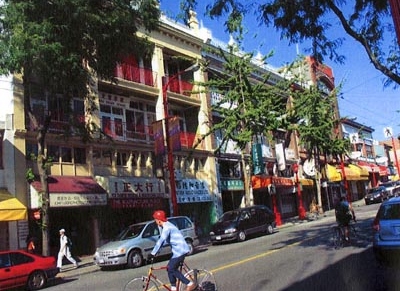
© Parks Canada
Established in the 1880s, Vancouver’s Chinatown is one of the oldest and largest Chinatowns in Canada. Its development as a self-segregated enclave, due in part to racially-motivated hostility elsewhere in the city prior to the Second World War, and its ongoing use reflect the many contributions and struggles of Chinese Canadians throughout most of their history in this country. Its architecture is characterized by a distinctive “recessed balcony” style, a hybrid that blends aspects of the architecture of Guangdong Province of China with western styles and construction methods. It is also one of the earliest established communities of Vancouver and has remained a vital physical and cultural part of the city.
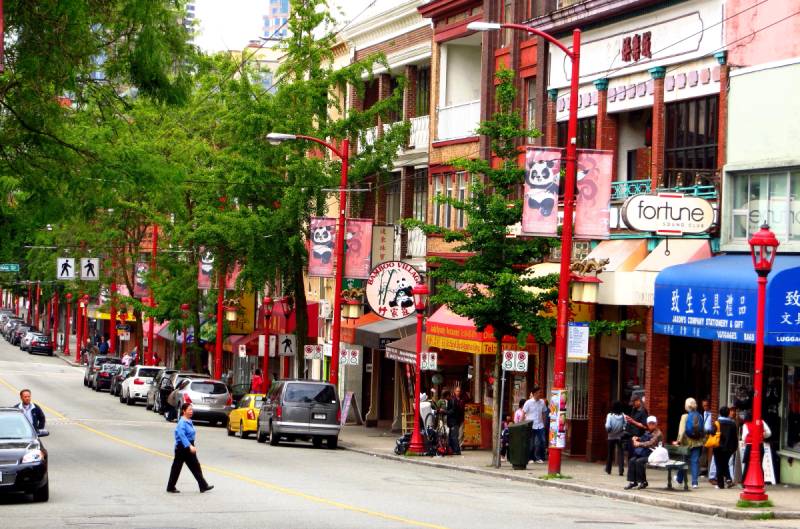
© Wikimedia Commons / Xicotencatl / https://commons.wikimedia.org/wiki/File:Vancouver_Chinatown_
16.JPG
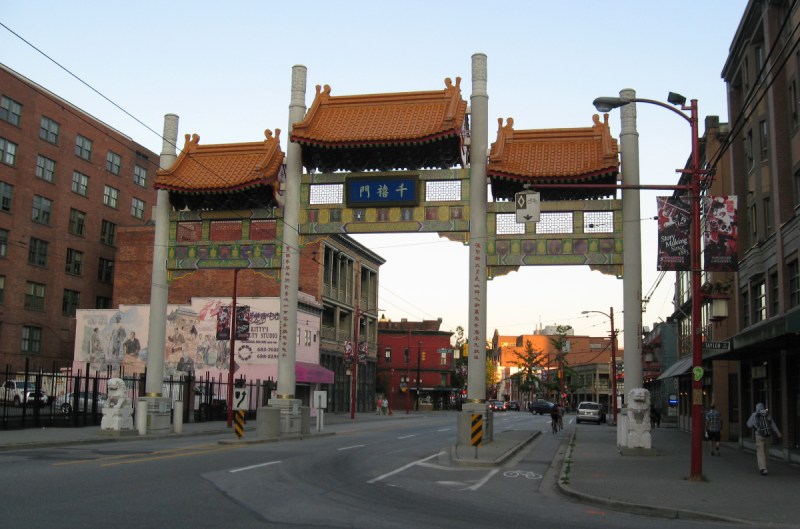
© Wikimedia Commons / MRDXII / https://commons.wikimedia.org/wiki/File:Millennium_Gate,_
Vancouver%27s_Chinatown_National_Historic_Site_of_Canada,_
WLM2012.jpg
Vancouver’s Chinatown began in the early 1880s when a number of Chinese people settled at the end of Carrall Street. When Vancouver was incorporated in 1886, the Chinese were granted a 65 hectare (160-acre) lease on the outskirts of town, and by the end of that year, a small Chinese settlement had grown on Dupont Street (named East Pender after 1904) west of Main Street. As a result of discrimination and segregation, Vancouver’s Chinatown developed as a distinctive and self-contained neighbourhood that grew with the city. By 1900, Chinatown boasted some 60 businesses and by 1901 its population was almost 2,900. During the 1910s and 1920s, many of the neighbourhood’s buildings standing today were constructed; these included commercial buildings erected by Chinese merchants, and Society buildings, built to accommodate the cultural associations to which many Chinese belonged. By 1921, the neighbourhood’s population had risen to 6,484. However, the implementation of the Chinese Immigration Act in 1923, the neighbourhood went into a period of stagnation, and the community of largely aging bachelor men was unable to grow without new immigration. The Great Depression also devastated Chinatown. With changing attitudes and policies in the period after the Second World War, Chinatown again began to flourish with a great influx of population.
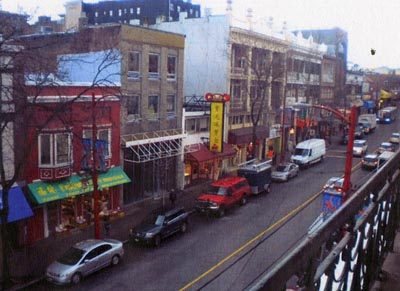
© Parks Canada / Kate MacFarlane
Centred on Pender Street, Chinatown’s distinctive physical character is derived in large part from its buildings and streetscapes. Their features when taken together create a harmonious ensemble. Within the neighbourhood there are 70 contiguous properties, representing a mix of commercial, residential, and cultural buildings, along with courtyards and alleys. The vast majority of Chinatown’s buildings are constructed at the front property lines, and vary in height from two to four storeys. At street level, pedestrians are treated to a lively assortment of commercial uses, while the upper floors of buildings are typically developed for office, institutional and residential uses. Common architectural features include recessed balconies, a strong verticality, and high ceilings at ground-level with mezzanines. By combining aspects of both western and Chinese regional architectures, the neighbourhood’s buildings represent a distinctive style known as “balcony” or “Chinatown” style. Overall, the architecture of Chinatown reflects its occupants’ heritage, social structure, and ways of life.
Vancouver’s Chinatown has been described as a functioning, working neighbourhood that also plays an important role in tourism for Vancouver and British Columbia. A distinct urban landscape with a specific vernacular architecture, its enduring culture is expressed through a historic concentration of Chinese Canadian businesses, services, cultural facilities, and residential structures, and is reinforced by the community associations still headquartered there.
Backgrounder last update: 2017-04-27.
Description of historic place
Vancouver’s Chinatown National Historic Site of Canada is a distinct neighbourhood on the east side of downtown Vancouver, British Columbia. It is centred on Pender Street, between Taylor Street in the West and Gore Avenue in the East and the lanes north and south of Pender. Its buildings are characterized by a distinctive hybrid architectural style that blends aspects of Chinese regional architecture with western styles and building methods. The main streets follow a traditional 1880s grid pattern while the north side is distinct to Chinatown with interior courtyards, passageways, alleys, and main facades that face both streets and laneways. Constructed to the property lines, the mostly two to four storeys buildings provide commercial, institutional, and residential space. The neighbourhood’s uniform layout changes on its south side. Here the large Chinese Cultural Centre is set back, with a large courtyard leading to the district’s largest open public space, the Dr. Sun Yat-Sen Chinese Classical Garden. Official recognition refers to an irregular polygon precisely corresponding to the City of Vancouver’s Chinatown Historic Area District Schedule (HA-1).
Heritage value
Vancouver’s Chinatown was designated as a National Historic Site of Canada in June 2010 because:
- one of the oldest and largest Chinatowns in the country, its physical fabric, its development as a self-segregated enclave, due in part to racially motivated hostility elsewhere in the city prior to the Second World War, and its ongoing uses reflect the many contributions and struggles of Chinese Canadians throughout most of their history in this country;
- it [Vancouver’s Chinatown] is characterized by a distinctive “recessed balcony” style of architecture, a hybrid style that blends aspects of Chinese regional architecture with western styles and building methods that is seen most clearly in Vancouver’s Chinatown. Common architectural features include deeply recessed balconies, a strong verticality, mezzanines, and a separate, narrow door at grade leading to a deep staircase to the upper floors. These features taken together create a harmonious ensemble;
- and, Chinatown is one of the earliest established communities of Vancouver and has remained a vital element of the physical and cultural history of the city.
In addition, the heritage value of Vancouver’s Chinatown lies in its ties to the development of the social and cultural life of Chinese immigrants to British Columbia and Canada, and to the commercial activities of Vancouver’s original business and port districts. The district is defined by its form, embellishments, layout and architecture. Incorporated in1886, Vancouver became a major point of entry for new Chinese immigrants, many of whom settled in Vancouver’s Chinatown. Chinese labourers were granted a 160-acre lease and built their settlement along Main Street at East Pender. In the early 1900s, Vancouver’s Chinatown became Canada’s leading Chinatown, remaining so until the 1970’s. Within the district’s streetscapes the 70 contiguous properties are a mix of commercial, residential and cultural buildings, alleys and courtyards, many dating from the early 20th century. Significant newer cultural resources, such as the Dr. Sun Yat-Sen Chinese Classical Garden and Park (1986), the Chinese Cultural Centre (1981-86) and the Millennium Gate (2002), enhance the traditional Chinese character of the area.
Protected since 1971 under provincial and municipal heritage legislation, the area has 24 properties listed on the Vancouver Heritage Register. Vancouver’s Chinatown displays a continuity and connection to its past, and – as a working urban neighbourhood - offers lively contrasts between its peaceful public garden, distinctive buildings and colourful street-life.
The National Program of Historical Commemoration relies on the participation of Canadians in the identification of places, events and persons of national historic significance. Any member of the public can nominate a topic for consideration by the Historic Sites and Monuments Board of Canada.
- Date modified :